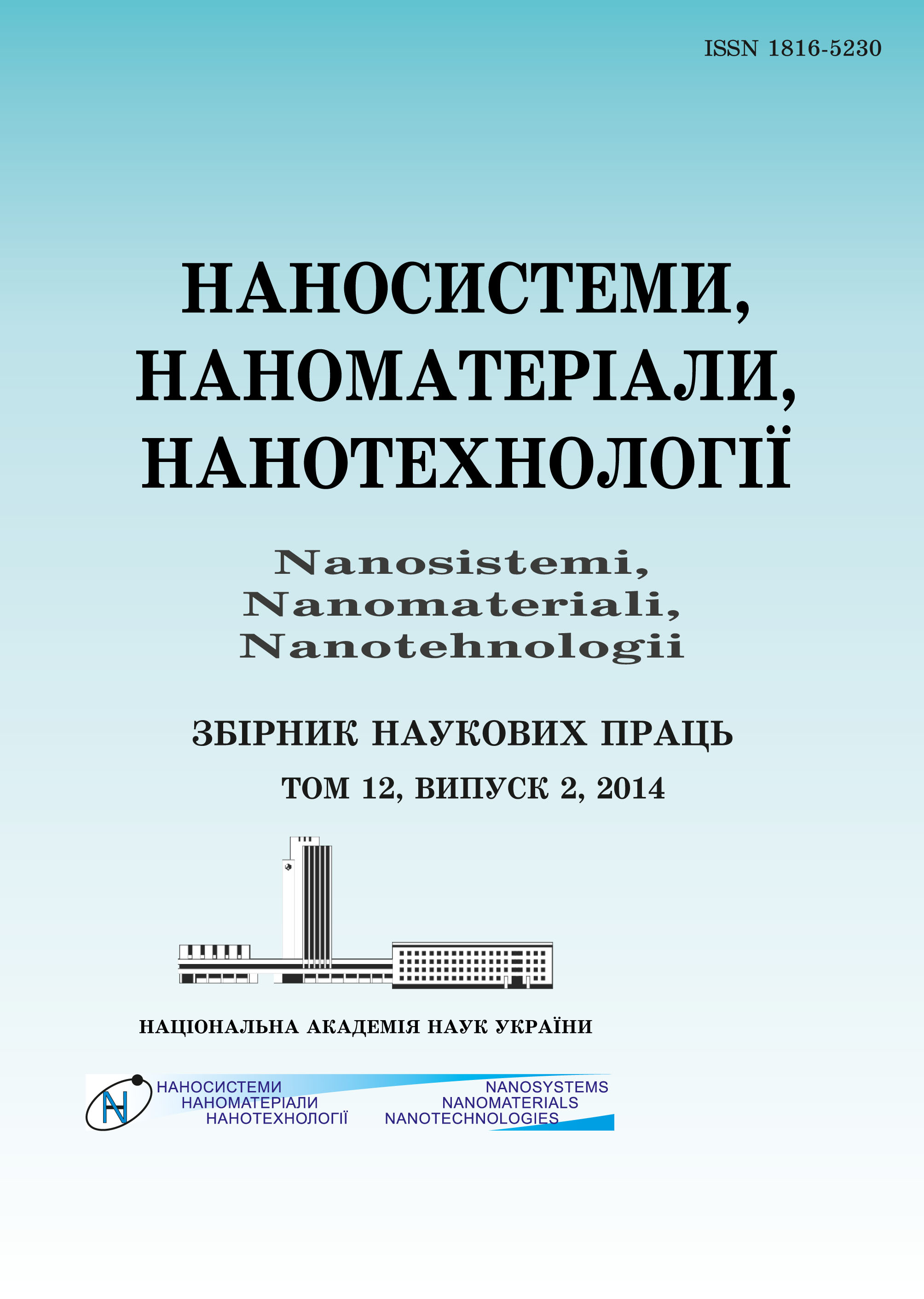|
|
|||||||||
 |
Year 2021 Volume 19, Issue 1 |
|
|||||||
|
|||||||||
Issues/2021/vol. 19 /Issue 1 |
O. K. Shuaibov, O. Y. Minya, A. O. Malinina, O. M. Malinin, I. V. Shevera
«Electroluminescence of Aluminium-Oxides’ Nanoparticles in Overstressed Nanosecond Discharge Plasma in High-Pressure Air»
0189–0200 (2021)
PACS numbers: 52.77.Fv, 52.80.Tn, 78.20.Ci, 78.60.Fi, 78.60.Hk, 78.67.Bt, 82.33.Xj
The results of the study of the electroluminescence of aluminium-oxide nanoparticles in plasma of an overstressed bipolar nanosecond discharge ignited between aluminium electrodes at an interelectrode distance of 2 mm and under an air pressure in the range of 50–202 kPa are presented. Aluminium vapour was introduced into the plasma due to microexplosions of inhomogeneities on the surface of the electrodes in a strong electric field (E). The plasma of the discharge under study is characterized by a wide luminescence band in the spectral range of 300–430 nm, against the background of which, spectral lines of aluminium atoms and ions as well as nitrogen atoms and ions are observed. When air was replaced by argon of the same pressure and under the same ignition conditions of the discharge, these luminescence bands were absent. Based on the well-known published data on photo- and cathodoluminescence of solid-state alumina nanostructures, the broad luminescence bands from plasma were detected and attributed to the emission of the F and F\(^+\) centres formed by oxygen vacancies in aluminium-oxide nanoparticles. The transmission spectra of thin films synthesized on glass substrates from plasma products were studied. Based on the BOLSIG+ program, the basic parameters of air plasma with a small admixture of aluminium vapour were simulated for the values of the E/N parameters (the ratio of the electric field (E) to the total concentration of the mixture of aluminium and air vapours (N)), which were realized in the experiment.
Keywords: electroluminescence, nanostructures, aluminium, overstressed nanosecond discharge, argon, air
https://doi.org/10.15407/nnn.19.01.189
References
1. V. A. Bityurin, A. V. Grigorenko, A. V. Efimov, A. I. Klimov,O. V. Korshunov, D. S. Kutuzov, and V. F. Chinnov, High Temperature, 52:3 (2014); https://doi.org/10.7868/S00403644140100502. E. I. Shkolnikov, A. Z. Beetle, B. M. Bulychev, M. N. Larichev,A. V. Ilyukhina, and M. S. Vlaskin, Oxidation of Aluminum with Water forEfficient Power Generation (Moscow: Science, Joint Institute for High Tem-peratures, RAS: 2012).
3. M. A. Krasnogolovets, Technical Physics, 44: 1388 (1999); https://doi.org/10.1134/1.1259531
4. D. V. Beloplotov, V. F. Tarasenko, and M. I. Lomaev, Optika Atmosfery iOkeana, 29, No. 2: 96 (2016) (in Russian).
5. V. S. Kortov, A. E. Ermakov, A. F. Zatsepin, M. A. White, S. V. Nikiforovet al., Solid State Physics, 50: 916 (2008); https://doi.org/10.1134/S1063783408050259
6. I. V. Gasenkova, N. I. Mukhurov, and Yasin Mohsin Vakhioh, Reports ofBSUIR, 96: 114 (2016).
7. G. A. Mesyats, Usp. Fizich. Nauk, 165: 601 (1995) (in Russian);200O. K. SHUAIBOV, O. Y. MINYA, A. O. MALININA et al. https://doi.org/10.3367/UFNr.0165.199506a0601
8. A. K. Shuaibov, A. Y. Minya, A. A. Malinina, A. N. Malinin, V. V. Danilo,M. Yu. Sichka, and I. V. Shevera, Ameriñan Journal of Mechanical and Ma-terials Engineering, 2: 8 (2018); https://doi.org/10.11648/j.ajmme.2018.0201.12
9. A. K. Shuaibov, A. I. Minya, Z. T. Gomoki, V. V. Danilo, andP. V. Pinzenik, Surface Engineering and Applied Electrochemistry, 55: 65(2019); https://doi.org/10.3103/S1068375519010137
10. O. K. Shuaibov, A. A. Malinina, and A. N. Malinin, New Gas-DischargeMethods for Producing Selective Ultraviolet and Visible Radiation and Syn-thesis of Transition Metal Oxide Nanostructures (Uzhhorod: Publishinghouse UzhNU ‘Goverla’: 2019).
11. V. F. Tarasenko, Runaway Electrons Preionized Diffuse Discharge (NewYork: Nova Science Publishers Inc.: 2014).
12. V. M. Holovey, K. P. Popovych, M. V. Prymak, M. M. Birov,V. M. Krasilinets, and V. I. Sidey, Physica B, 450: 34 (2014); https://doi.org/10.1016/j.physb.2014.05.059
13. A. K. Shuaibov, A. Y. Minya, Z. T. Gomoki, R. V. Hrytsak, A. A. Malinina,and A. N. Malinin, Journal of Physics and Chemistry Research, 1: 1 (2019).
14. Ya. Vertsimakha, P. Lutsuk, O. Lytvyn, and P. Gashin, Ukr. J. Phys., 52:399 (2007).
15. G. F. Novikov and M. V. Gapanovich, Physics-Uspekhi, 187: 173 (2017); https://doi.org/10.3367/UFNr.2016.06.037827
16. G. J. M. Hagelaar and L. C. Pitchford, Plasma Sources Sci. Technol., 14:722 (2005); https://doi.org/10.1088/0963-0252/14/4/011
17. http:/www.bolsig.laplace.univ-tlse.fr
18. L. L. Shimon, Scientific Bulletin of Uzhhorod University. Physics Series, 20:55 (2007).
19. http://www.ioffe.ru/ES/Elastic/data2.html
20. https://physics.nist.gov/cgi-bin/Ionization/ion_data.php?id=AlI&ision=I&initial=&total=Y
 This article is licensed under the Creative Commons Attribution-NoDerivatives 4.0 International License ©2003—2021 NANOSISTEMI, NANOMATERIALI, NANOTEHNOLOGII G. V. Kurdyumov Institute for Metal Physics of the National Academy of Sciences of Ukraine. E-mail: tatar@imp.kiev.ua Phones and address of the editorial office About the collection User agreement |